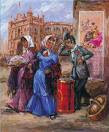
Reino de España
Capital City: Madrid
Official Language: Spanish (some regions have their own language, such as Catalan, Basque, Galician, Leonese, Portuguese, and etc.)
Most important cities: Madrid, Barcelona, Cordoba, Valencia, Seville, Zaragoza, Malaga, Murcia, La Palmas de Gran Canaria, Bilbao, Valladolid
Currency: Euro
Man, what a work out!! I had to drag and lift the luggage up and down many stairs; luckily they were not too heavy. To get to the hotel we took the metro. Madrid Barajas International Airport, MAD, is connected to the Merto line 8,
pink line. For 2 euro a ticket it is an affordable alternative to taking a cab to get to any place in the city.
(Madrid Subway Map)The hotel is in a perfect place, in the heart of Old City. The room and most importantly the bathroom is spotless clean. There is air condition, a must have in summer, an LCD TV and a laptop that comes with a free internet in the room. The furniture is trendy, contemporary. The hotel is called, High Tech - Petit Palace operated by the High Tech Hotels company.
(Visit their site)Jet lagged, exhausted and constipated, we made a short trip to a few places around the old city Madrid, had an unforgettable ice-cream ceremony, washed, and slept.
We stayed 3 nights in Madrid and enjoyed an array of activities such as sight seeing, shopping, eating and the unforgettable Fiesta de La Paloma.

The La Paloma festival, August 6-15, honors the La Paloma Virgin, one of the three loved *Virgins* known to be the protector of the Madrid dwellers. The extravagant, loud, fun festival in the height of the summer is very real. Men and women dressed in colorful, traditional outfit of a Chulapos or Chulapas dance, walk and have and create fun in the streets surrounding La Latina. For the more contemporary, the youth, the Madridians, Spanish and international tourists the casual clothes will do, so long as you join in the dance, enjoy the loud music (different on each street), and drink limonada, tequila, or etc. (
Have a look at the Chulapos and Chulapas getting ready to celebrate the La Paloma Festival, Madrid 2009)
On the fourth day we packed and left for the Madrid bus station to continue with our trip in Spain. The bus station was not too far from the hotel. Again we chose to get there via the subway line. I found the Madrid subway extremely organized, clean and easy to navigate. All the stations display the next train arrival time; the next station is both announced and displayed on screen in the train. The Mendez Alvaro bus station is on line 6,
gray, and accessible via line 1,
light blue, and line 3, yellow. The avanzabus company connects Madrid to all the regions in Spain. When I booked, they had 2 for 1 deals on their web site. I saved 20eurnos by booking on-line. (
Check them out)
Madrid money and time saving tips:
- Stay around Sol subway station to save on transportation cost; all sites are within walking distance; wide range of traditional and fast food restaurants in this area.
- Navigate the Museo Del Prado museum using their Masterpieces plan.
- Take advantage of free or reduced admission, if you qualify, to Museo Del Prado (Sunday - Tuesday 6-8 PM)

The capital of Valencia Province, the city of Valencia has been an agricultural and industrial center throughout its history. It is located on the Mediterranean Sea at the mouth of the Turia River in a region surrounded by orchards. It is Spain's third largest city. (source: student.britannica.com)
Four and a half hours later we were in Valencia. Situated in the middle of the Spanish Mediterranean coast, Valencia is the third largest city in Spain. For us Valencia meant a three days opportunity to rest and relax under the sun before we head to the next big city. Or so we thought. Intentionally, we reserved a
hotel close to the beach. But on the ride to the hotel far distance from the bus station, (total cost 10euro), as our eyes became more familiar to the palm trees, wide streets (unlike Madrid) and contemporary architecture (especially the L'oceanographic museum) we were determined to sight see as much as possible. But, first we had to indulge in the food we so much heard and read about. They said we could find the fancy restaurants by the sea. We see the sea in the far distance but there was no sight of any restaurants. To make matters a bit more challenging most roads were blocked and cars were being redirected to detours, while the city was getting ready for the next weekend's, August 22-23, Europe's Grand Prix Formula 1 race. When we finally got to the beach we were too tired, too hungry to shop around for restaurants. We walked into the second restaurant because the first one was closed. Al Coso was its name. Great place. They have the most delicious Spanish mixed rice. They even treat you to fresh oven baked bread while you are waiting for your food to arrive. Satisfied, we left Al Coso to take walk on the sandy beach.
Valencia's city bus transit ticket is 1.35 euro, paid to the bus driver. It's best to have the exact change or amount close to it. The next buses are announced on most (but not all) buses. Bus 19 goes to the city center, Ayunmiento. Once there, all the historical places are in walking distance of each other. There are a variety of souvenir stores in that area that offer unique works of art, and jewelry at a very affordable price. It was hard to leave this charming city. It was hard to see the last days of this, so far fantastic trip is arriving.
Essential Valencia:
- Bioparc
- Jardin del Turia
- Torres de Serranos-Torres de Quart
- Catedraly Basilica
- Lonja
- Mercado Central
- Mercado de Colon
- Ciudad de las Artes y las Ciencias
- Marina Real Juan Carol-I-Paseo Maritimo-Playas
- Parque Natural de l'Albufera
Barcelona, was unlike any other place. It is said to be the seventh city in Europe in number of tourists it receives. Given the city structure and the situation of the important sights, we got ourselves T10 metro pass, (more economical than buying one ticket, 2.80 euro, at a time), and started our journey at the La Sagrada Familia, (Antoni Gaudí1882). It took Gaudi 43 years to bring it to the stage that we see today. He finished the two facades; the birth and crucifying of Christ. The characters, in each story, are meticulously carved to the extent their emotion is obvious. I would not been surprised if you spend at least an hour outside the church. It is worth every minute the time you spend or every picture you shoot. Inside, you can see Gaudi's innovation; his use of geometry and incorporating natural light into his design. In designing the ceiling, the pillars and the windows, Gaudi was inspired by nature. As a result, his creation is by far like no other church! It is unique in every sense of the word. La Sagrada Familia is work in progress! The plan is to have the third facade based on Gaudi's design completed by 2050. The story is based on Christ's rise from dead.










